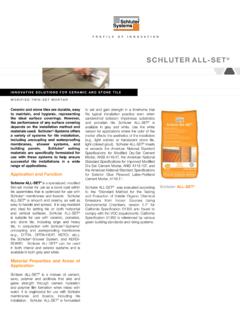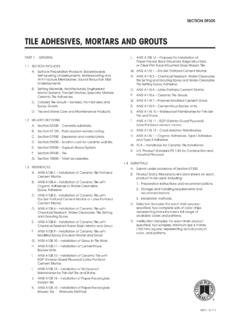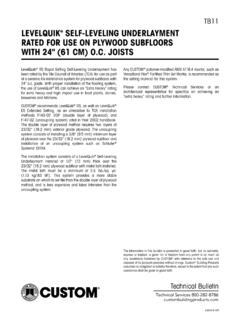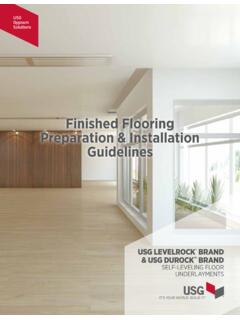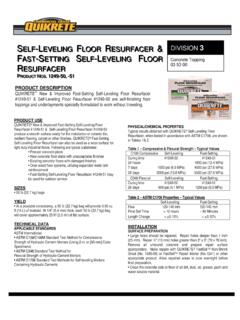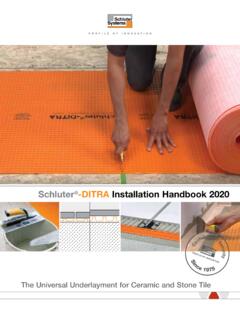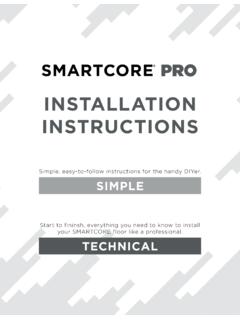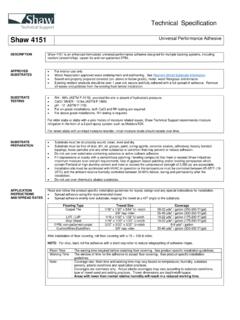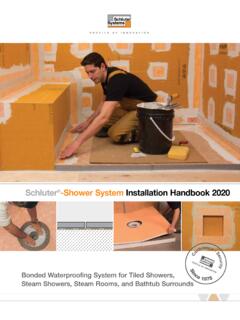Transcription of Schluter -DITRA-HEAT Installation Guide
1 555032 04/2016 2016 Schluter Systems Schluter -DITRA-HEAT Installation GuideEsta gu a est disponible en espa ol. Para obtener una copia, llame por tel fono a nuestro servicio al cliente o desc rguela desde nuestro sitio Internet : 3 Details8 Movement Joints9 Wood UnderlaymentInstallation10 Membrane11 Heating Cables16 Thin-set Facts16 Testing & Certifications18 208 V Applications19 Heating Cable Tests Log20 WarrantySchluter -Systems written Installation instructions shall have precedence over referenced industry standard guidelines and Installation procedures insofar as referenced information may contain overlapping or conflicting requirements. Type, thickness, and format of the ceramic or stone tile surface covering must be suitable for the intended cables must be installed by a qualified person in accordance with this handbook and with the National Electric Code (USA) or Canadian Electric Code Part I (CAN) as applicable.
2 All electrical connections must be made by a qualified electrician, according to the electrical and building codes effective in your region. 3 WOOD16" (406 mm) joist spacing, single layer OSB or plywood subfloorFloors, Interior - Ceramic or Porcelain " (488 mm) joist spacing, single layer OSB or plywood subfloorDH-W19-T-16DH-W16-T-16 Ceramic or porcelain tileUnmodified thin-set mortar DITRA-HEAT or DITRA-HEAT-TB uncoupling membrane and heating cablesLatex mortarSingle layer of plywood or OSBJ oists, I-joists, or trussesCeramic or porcelain tileUnmodified thin-set mortar DITRA-HEAT or DITRA-HEAT-TB uncoupling membrane and heating cablesLatex mortarSingle layer of plywood or OSBJ oists, I-joists, or trussesAreas of Application over any even and structurally sound OSB or plywood subfloor with 16" (406 mm)
3 Joist spacing interior dry or wet areasLimitations minimum 2" x 2" (50 mm x 50 mm) tile for natural stone, see detail DH-W-S (page 4) Requirements maximum spacing of joists, I-joists, or floor trusses is 16" (406 mm) minimum subfloor thickness 19/32", 5/8" nom. (16 mm) tongue-and-groove with 1/8" (3 mm) gap between Preparation verify that subfloor panels are properly fastened to framing members. any leveling of the subfloor must be done prior to installing DITRA-HEAT and Joints DITRA-HEAT and DITRA-HEAT-TB do not eliminate the need for movement joints, including perimeter joints, within the tiled surface. Movement joints must be installed in accordance with industry standards and norms; see page 8 of this Handbook, TCNA EJ171, and TTMAC 301 MJ.
4 Setting and Grouting Materials latex portland cement ( ) mortar ANSI unmodified thin-set mortar ANSI grout ANSI , , , and Grouting Specifications tile ANSI grout ANSI , , Considerations tightly butted and/or tented plywood or OSB seams must be addressed prior to installing DITRA-HEAT and DITRA-HEAT-TB. vapor barrier on crawl space floors according to regional building codes. where a waterproof floor is required, all DITRA-HEAT and DITRA-HEAT-TB seams and floor/wall transitions must be sealed with KERDI-BAND using unmodified thin-set mortar; see page 7. Areas of Application over any even and structurally sound OSB or plywood subfloor with " (488 mm) joist spacing interior dry or wet areasLimitations minimum 2" x 2" (50 mm x 50 mm) tile for natural stone, see detail DH-W-S (page 4) Requirements maximum spacing of joists, I-joists, or floor trusses is " (488 mm) minimum subfloor thickness 23/32", 3/4" nom.
5 (19 mm) tongue-and-groove with 1/8" (3 mm) gap between Preparation verify that subfloor panels are properly fastened to framing members. any leveling of the subfloor must be done prior to installing DITRA-HEAT and Joints DITRA-HEAT and DITRA-HEAT-TB do not eliminate the need for movement joints, including perimeter joints, within the tiled surface. Movement joints must be installed in accordance with industry standards and norms; see page 8 of this Handbook, TCNA EJ171, and TTMAC 301 MJ. Setting and Grouting Materials latex portland cement ( ) mortar ANSI unmodified thin-set mortar ANSI grout ANSI , , , and Grouting Specifications tile ANSI grout ANSI , , Considerations tightly butted and/or tented plywood or OSB seams must be addressed prior to installing DITRA-HEAT and DITRA-HEAT-TB.
6 Vapor barrier on crawl space floors according to regional building codes. where a waterproof floor is required, all DITRA-HEAT and DITRA-HEAT-TB seams and floor/wall transitions must be sealed with KERDI-BAND using unmodified thin-set mortar; see page 24" (610 mm) joist spacing, double layer OSB or plywood subfloorDH-W24-T-16 Floors, Interior - Natural Stone TileDouble layer of OSB or Plywood subfloorDH-W-S-16 Floors, Interior - Ceramic or Porcelain TileCeramic or porcelain tileUnmodified thin-set mortarDITRA-HEAT or DITRA-HEAT-TB uncoupling membrane and heating cablesLatex mortarDouble layer of plywood or OSBI-joists or trussesNatural stone tileUnmodified thin-set mortarDITRA-HEAT or DITRA-HEAT-TB uncoupling membrane and heating cablesLatex mortarDouble layer of plywood or OSBJ oists, I-joists, or trussesAreas of Application over any even and structurally sound double layer OSB or plywood floor interior dry or wet areasLimitations minimum 2" x 2" (50 mm x 50 mm)
7 TileRequirements maximum spacing of joists, I-joists, or floor trusses is 24" (610 mm) double layer wood floor consisting of: minimum subfloor thickness 23/32", 3/4" nom. (19 mm) tongue-and-groove minimum underlayment thickness 11/32", 3/8" nom. (10 mm)Substrate preparation verify that subfloor panels are properly fastened to framing members. underlayment minimum 11/32", 3/8" nom. (10 mm)-thick Exposure 1, plugged-face plywood or OSB with 1/8" (3 mm) gap between sheets; see page 9 for underlayment Installation guidelines. any leveling of the subfloor must be done prior to installing DITRA-HEAT and Joints DITRA-HEAT and DITRA-HEAT-TB do not eliminate the need for movement joints, including perimeter joints, within the tiled surface.
8 Movement joints must be installed in accordance with industry standards and norms; see page 8 of this Handbook, TCNA EJ171, and TTMAC 301 MJ. Setting and Grouting Materials latex portland cement ( ) mortar ANSI unmodified thin-set mortar ANSI grout ANSI , , , and Grouting Specifications tile ANSI grout ANSI , , Considerations tightly butted and/or tented plywood or OSB seams must be addressed prior to installing DITRA-HEAT and DITRA-HEAT-TB. vapor barrier on crawl space floors according to regional building codes. where a waterproof floor is required, all DITRA-HEAT and DITRA-HEAT-TB seams and floor/wall transitions must be sealed with KERDI-BAND using unmodified thin-set mortar; see page of Application over any even and structurally sound double layer OSB or plywood floor interior dry or wet areasLimitations requires double layer wood floor regardless of joist spacing minimum 2" x 2" (50 mm x 50 mm) tileRequirements maximum spacing of joists, I-joists, or floor trusses is 24" (610 mm) double layer wood floor consisting of: minimum subfloor thickness 23/32", 3/4" nom.
9 (19 mm) tongue-and-groove minimum underlayment thickness 11/32", 3/8" nom. (10 mm)Substrate Preparation verify that subfloor panels are properly fastened to framing members. underlayment minimum 11/32", 3/8" nom. (10 mm)-thick Exposure 1, plugged-face plywood or OSB with 1/8" (3 mm) gap between sheets; see page 9 for underlayment Installation guidelines. any leveling of the subfloor must be done prior to installing DITRA-HEAT and Joints DITRA-HEAT and DITRA-HEAT-TB do not eliminate the need for movement joints, including perimeter joints, within the tiled surface. Movement joints must be installed in accordance with industry standards and norms; see page 8 of this Handbook, TCNA EJ171, and TTMAC 301 MJ.
10 Setting and Grouting Materials latex portland cement ( ) mortar ANSI unmodified thin-set mortar ANSI grout ANSI , , , and Grouting Specifications tile ANSI grout ANSI , , Considerations certain moisture-sensitive stones, , green marble, or resin-backed tiles may require special setting materials. Consult stone supplier and Schluter -Systems for more information. tightly butted and/or tented plywood or OSB seams must be addressed prior to installing DITRA-HEAT and DITRA-HEAT-TB. vapor barrier on crawl space floors according to regional building codes. where a waterproof floor is required, all DITRA-HEAT and DITRA-HEAT-TB seams and floor/wall transitions must be sealed with KERDI-BAND using unmodified thin-set mortar; see page 7.

